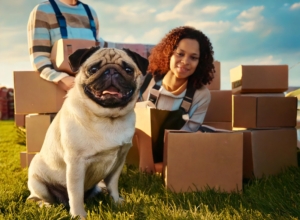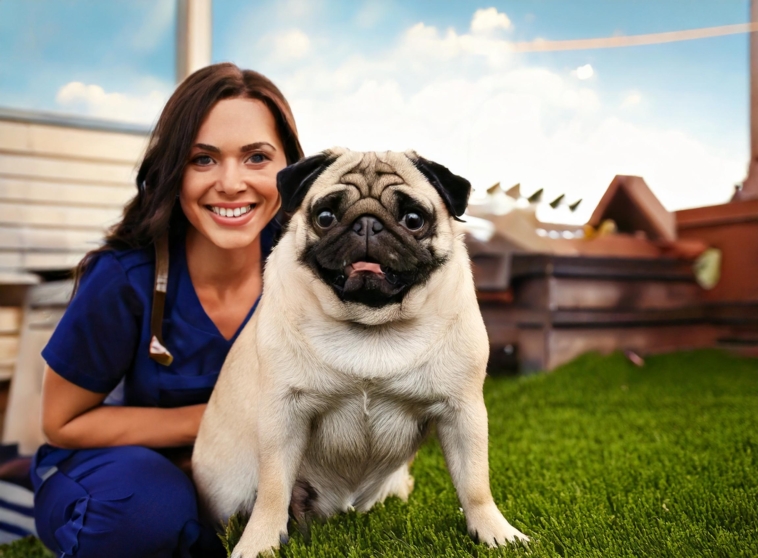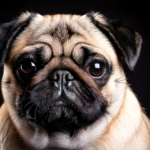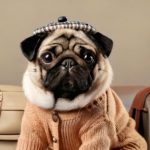Welcome to Planet Pug: A Not-So-Serious (But Totally Useful) Guide to Owning a Pug
Meet the Pug: The Squishy-Faced Superstar
Behold, the pug. That face-planted, wide-eyed, curly-tailed beauty that appears to have wandered face-first into a wall and declared its intent to own the look. Born in ancient China’s Han dynasty, pugs once warmed the laps of emperors. Skip ahead to the modern era, and they’re still as indulged—only now they’re taking over your bed and snoring like grandpa.
Pugs are sweet, affectionate, a bit dramatic, and obsessed with being the center of attention. Essentially, they’re miniature celebrities with hair.
Key Stats:
- Size: Small enough to rest in your lap, but heavy enough to make your legs sleep (14–18 pounds).
- Lifespan: 12–15 years of unadulterated snuggle tyranny.
- Coat: Short, sleek, and constantly shedding. Bonus: your clothing now includes built-in pug glitter.
Temperament:
- Loving: They’ll accompany you to the bathroom like it’s a rescue mission.
- Playful: Prepared for tug-of-war or a 3-hour nap—whichever finishes first.
- Mischievous: Will pilfer your socks and your heart.
Preparing Your Home for the Royal Arrival
Getting a pug? Congratulations. You’re about to be outsmarted by a dog who looks like a cinnamon roll. Here’s how to prep your home for the royal highness:
- Designate a Space: Your pug needs a throne—aka a cozy bed and a toy corner.
- Pug-Proofing: Hide wires, block escape tunnels, and remove anything smaller than a donut. If it fits in their mouth, it’s going in.
- Soft Bedding: Pugs need comfort. Consider orthopedic mattress, not cardboard box.
- Food & Water Bowls: Make them accessible unless you like dramatic pug hunger strikes.
- Toys: Chew toys that are durable. Otherwise, your shoes are theirs for the taking.
- Temperature Control: Pugs overheat quicker than your phone on 1% battery. Keep it cool.
Puppy-Proofing: Because Baby Pugs are Chaos in Fur Form
Tiny pug. Big personality. Puppy-proof your home like you’re expecting a four-legged tornado.
- Lock Up Toxic Stuff: Cleaning supplies, meds, and anything labeled “Do Not Eat” should be locked away.
- Hide Wires: Pugs love cords. Their teeth do not.
- Close Off Nooks and Crannies: If they can squeeze in, they will. Then they’ll cry for help.
- Remove Small Objects: Buttons, coins, jewelry. all seen as snacks.
- Safety Gates: Since closed doors are merely enigmatic possibilities to pugs.
So You Want a Pug? Here’s Your Shopping List
Think of it as getting ready for a baby. A baby who snores.
- Collar and Leash: Adjustable, solid, and preferably pug-proof.
- Bowls: Stainless steel or ceramic—no plastic, if you can help it.
Vet visits are not an option if you like having all your fingers and toes attached. - Food: Nutrient-dense and pug-approved. Plus points if something’s awful-smelling to humans.
- Crate or Bed: Their personal spa retreat.
- Toys: Sturdy enough to withstand the fury of pug zoomies.
- Grooming Tools: Brush, nail clippers, shampoo, and likely a lint roller for yourself.
- Pee Pads: Since small bladders and large carpets do not go.
Feeding Time: AKA The Highlight of a Pug’s Day
Pugs do not eat. They breathe. And then pretend they have not eaten in weeks.
- Portion Control: Measure out every bite. Pugs gain pounds quicker than you can say “extra treat.”
- Stick to a Schedule: Two meals daily. No midnight feast.
- Low-Cal Treats: They will beg. Be firm. Present something healthy. Sob internally.
- Hydration: Water at all times. Pretty fountains not necessary.
- Adjust for Weight & Age: There isn’t a one-size-fits-all. Consult your vet, not the web.
Training Your Pug (Or Trying To)
Training a pug is akin to negotiating with a very cute, very obstinate diplomat.
- Consistency is Key: Keep to a routine. Pugs live on routine. until they choose not to.
- Rewards Work Wonders: Treats, praise, and perhaps some jazz hands.
- Keep Sessions Short: 10–15 minutes. After that, they’re mentally out of it.
- Socialize Early: Get them used to everything before they form an opinion. Including your cat.
- Patience is Needed: Pug training is a trial of will. Ours, not theirs.
Exercise: Yes, Even the Couch Potatoes Need It
Even though they look all loafy, pugs require exercise.
- Daily Walks: Two short ones. Anything longer, and you’ll be dragging them back.
- Playtime: Puzzles, fetch, and the occasional game of “Chase Me, I Stole Your Sock.”
- Indoor Fun: Tug-of-war is a favorite. Bonus points if they allow you to win.
- Stay out of the Heat: If it’s warm enough to bake cookies on the sidewalk, keep your pug inside.

Grooming: More Than Just Vanity
Looking this gorgeous requires effort—and a lint roller.
- Brushing: Daily, or about once or twice a week. Or every day, if you enjoy hairy furniture.
- Bathing: Monthly spa mornings. Dog shampoo, not your high-end coconut lavender.
- Wrinkle Cleaning: Those cute face creases are bacteria playgrounds. Clean them frequently.
- Nail Trimming: Every 2–3 weeks. Unless you want your pug click-clacking like tap shoes.
- Teeth Cleaning: Dog toothpaste only. Seriously, no minty fresh required.
Health Check: Know Your Pug’s Quirks
Pugs are constructed like soft tanks—with some delicate wiring within.
- Breathing Problems: Snoring, wheezing, and the occasional Darth Vader sounds are standard.
- Obesity: Pugs will eat until they are as wide as bread loaves. Hold back on portions.
- Skin Issues: Wrinkles can clog with gunk. Clean them or suffer the foul consequences.
- Dry Eyes: They can appear soulful-looking, but those peepers require moisture. Monitor for squinting.
- Hip Dysplasia: Their short legs weren’t designed for dancing. Handle them gingerly
Bonding with Your Pug: How to Become Their Favorite Human
You’re not just their owner. You’re their emotional support human.
- Routine Matters: Structure gives them a sense of purpose. and snack expectations.
- Treat-Based Training: Because nothing says “I love you” like bribery.
- Play Every Day: Even if it’s just a lazy game of tug on the couch.
- Groom Together: They may grumble, but secretly they love the attention.
- Be Present: Whether it’s cuddling, walking, or staring into each other’s eyes.
Socialization: Avoid Raising a Shy Diva
Your pug must get to know more than you and your refrigerator.
- Early Exposure: Humans, places, animals, vacuums. Acclimate them to the strange things in life.
- Positive Reinforcement: Any positive interaction merits a treat—at minimum, a high five.
- Training Classes: Not only for command learning, but for the forging of four-legged friendships.
- Routine: Structure keeps their attitude levels in check.
- Playdates: A good reason to show off your pug and perhaps meet other human dogs.
Traveling with a Pug: A Journey in Snorts and Snacks
Taking a pug with you on the road isn’t a journey—it’s an adventure.
- Vet Appointment First: Checkup, vaccinations, and the doc’s seal of approval.
- Carrier Life: Roomy, airy, and not covered in yesterday’s crumbs.
- ID Game Strong: Tags, microchip, and perhaps a wee passport (just for kicks).
- Comfort Items: Blankies, toys, and perhaps a snippet of your shirt.
- Potty Breaks: Frequently. Like, super frequently.
- Hydration Station: Always carry water around—unless you like grandstanding panting
Schedule Like a Pro: Pugs Need Structure (and Snacks)
Pugs adore routines nearly as much as they adore snacks. Here’s how to stay on track:
- Feeding Times: Same times daily. They will not forget. They will not quiet down.
- Exercise Slots: Morning wiggle time, evening wiggle time.
- Training Windows: Keep it consistent or risk pug rebellion.
- Grooming Time: Calendar it or live with the results.
- Social Time: Weekly friend gatherings are required—for both of you.
- Nap Time: Non-negotiable. Multiple naps. All day.
Finding the Right Vet: Because Pugs Need Professionals
Not every vet understands pugs. Yours should.
- Pug-Savvy Vet: Bonus points if they’ve treated snorty dogs before.
- Close to Home: Emergencies happen when you least expect them.
- Flexible Hours: Midnight ear infection? You’ll want a vet who’s open.
- Routine Checkups: Twice a year, minimum. More if your pug is an overachiever in drama.
- Dental Focus: Their teeth are small but mighty. and slightly chaotic.
- Weight Watch: They don’t call it “chonk prevention” for nothing.




